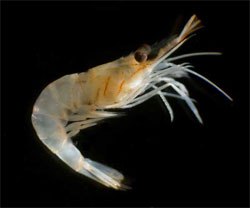White Shrimp: The Fruit of the Sea
Reproduction
Spawning of Penaeus
setiferus begins in March and April
and continues throughout the summer months. In this
species of shrimp, spawning occurs offshore.
Spawning usually occurs when the females shell is hard
and she is about to shed her exoskeleton. In a single
spawning up to one million eggs are released for fertilization.
During mating the male delivers a packet of sperm called a spermatophore to the posterior genital structure of the female.
The male structure that houses the spermatophores is called the
Petasma, meaning 'spread out' in Greek. The female structure
is called the Thelycum, meaning 'female'
in Greek. The male
trusts the Petasma into the thelycum, delivering the
spermatophore to the thelycum. The female then sheds her
exoskeleton and begins the process all over again. The
fertilized eggs sink to the floor of the ocean where they
develop and hatch 24 hours later. 
Female white shrimp tend to spawn
in the open waters off the coast of the Atlantic Ocean or the
Gulf of Mexico. The eggs need high saline water to hatch.
The water needs to be around 3.5% saline for the eggs to hatch
properly. As larvae shrimp grow they migrate to estuaries
with a very low salinity content. It takes a full year for
the larvae shrimp to reach full sexual maturity. The
shrimp then mate and die, completing their life cycle. The
females grow to be about twice the size of the males and
occasionally live a second year after spawning.
Only shrimp that have the best
nutrition
will have happy and healthy babies.